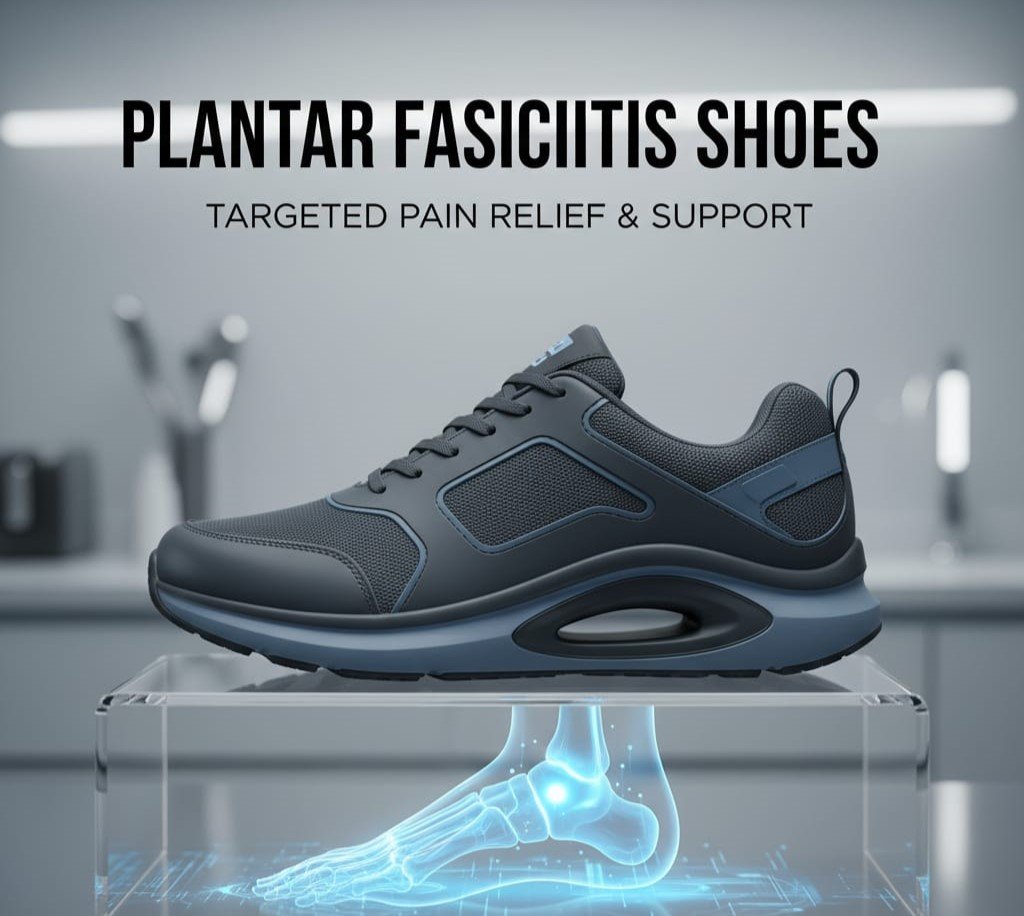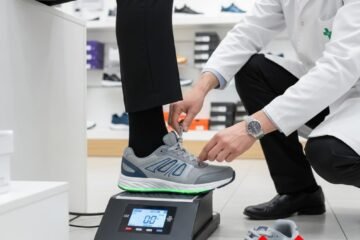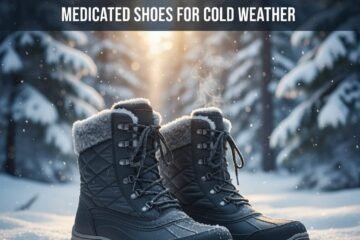🦶 Introduction: Walking in Pain — and Finding Relief
If you’ve ever felt a sharp, stabbing pain in your heel the moment you get out of bed, you might already know what plantar fasciitis feels like. It’s one of the most common causes of foot pain in adults, affecting athletes, workers, and everyday people alike.
The good news? Relief is possible — and it often starts with what’s on your feet.
Medicated shoes (or therapeutic footwear) are specifically designed to support your arch, cushion your heel, and reduce the stress on your plantar fascia. But with so many options on the market, choosing the right pair can feel overwhelming.
This guide will walk you through everything you need to know about selecting the best medicated shoes for plantar fasciitis — from understanding your condition to identifying features that truly make a difference.
🩻 Understanding Plantar Fasciitis
Before you buy shoes, it helps to understand what’s actually happening in your foot.
What Is Plantar Fasciitis?
The plantar fascia is a thick band of tissue that runs along the bottom of your foot, connecting your heel bone to your toes. Its job is to support your arch and absorb shock when you walk or run.
When this tissue becomes inflamed or overstretched, it leads to a condition called plantar fasciitis, characterized by heel pain that’s worst in the morning or after long periods of rest.
Common Causes Include:
- Wearing flat, unsupportive shoes
- Overuse (especially from running or standing long hours)
- Tight calf muscles or Achilles tendons
- Obesity or sudden weight gain
- Abnormal foot structure (flat feet or high arches)
Understanding the root cause of your pain helps you find footwear that addresses the right issues — not just masks the symptoms.
👟 What Are Medicated Shoes?
Despite the name, “medicated shoes” aren’t literally infused with medication. The term refers to therapeutic, orthopedic, or podiatrist-recommended footwear that’s engineered to provide medical-grade support for various foot conditions, including plantar fasciitis.
Key Benefits of Medicated Shoes
✅ Arch support that maintains foot alignment
✅ Extra cushioning to absorb shock
✅ Deep heel cups that stabilize the foot
✅ Removable insoles for custom orthotics
✅ Breathable materials that prevent irritation
These shoes aren’t just comfortable — they can help prevent further damage and promote natural healing.
🧠 Why Regular Shoes Don’t Work
You might be tempted to grab a trendy pair of sneakers or flats and hope for the best. Unfortunately, regular shoes often lack structural support where you need it most.
Common Shoe Mistakes
- Flat soles: Offer no arch or heel support
- Thin cushioning: Fails to absorb heel impact
- Improper fit: Causes tension in the plantar fascia
- Cheap insoles: Wear out quickly and lose structure
When you walk in unsupportive shoes, your plantar fascia stretches excessively — worsening inflammation and pain over time.
🩺 Key Features to Look For in Medicated Shoes
When choosing the best shoes for plantar fasciitis, pay attention to the following features.
1. Arch Support 🏗️
Strong arch support redistributes pressure evenly across your foot and prevents the fascia from overstretching.
Look for:
- Contoured footbeds
- Firm yet flexible midsoles
- Orthotic-grade insoles
💡 Tip: People with flat feet often need motion-control shoes, while those with high arches may benefit from cushioned, neutral-support models.
2. Heel Cushioning 💨
The heel is usually the most painful area for plantar fasciitis sufferers.
A deep heel cup stabilizes the foot, while extra padding absorbs impact from each step.
Recommended materials:
- Gel pads
- EVA foam
- Memory foam inserts
3. Sole Rigidity ⚙️
While flexibility may seem appealing, overly bendy soles can actually make plantar fasciitis worse.
A semi-rigid or firm sole helps maintain proper gait mechanics and prevents overpronation.
Check for:
- A slight rocker bottom (for smooth motion)
- Thick midsoles
- Sturdy outsole traction
4. Fit and Width Options 📏
Plantar fasciitis pain can worsen with shoes that pinch or squeeze your feet.
Choose shoes that allow toe splay and come in various widths (narrow, medium, wide).
👣 Pro Tip: Always try on shoes at the end of the day when your feet are slightly swollen — that’s when you’ll get the most accurate fit.
5. Material and Breathability 🌿
Comfort isn’t just about structure — it’s also about temperature and moisture control.
Look for breathable mesh uppers or natural leather that prevents sweating and irritation.
6. Removable Insoles 🧩
Removable insoles let you replace standard footbeds with custom orthotics prescribed by your podiatrist.
This flexibility ensures long-term comfort as your condition improves.
7. Comparison Chart: Key Features in Medicated Shoes for Plantar Fasciitis
🧩
| Feature | Purpose | Recommended Material / Design | Benefits for Plantar Fasciitis |
|---|---|---|---|
| Arch Support 🏗️ | Maintains natural foot alignment and reduces strain on the fascia | Firm midsole with contoured or orthotic-grade footbed | Relieves tension and distributes pressure evenly |
| Heel Cushioning 💨 | Absorbs shock from walking and running | Gel pads, EVA foam, or memory foam inserts | Minimizes heel pain and prevents inflammation |
| Deep Heel Cup ⚱️ | Stabilizes the foot and prevents overpronation | Structured heel cup with soft padding | Keeps the heel bone aligned and secure |
| Sole Rigidity ⚙️ | Controls motion and improves gait | Semi-rigid or rocker-bottom sole | Reduces stretching of the plantar fascia |
| Removable Insoles 🧩 | Allows use of custom orthotics | Detachable insoles with Velcro or slip-in slots | Offers personalized comfort and medical customization |
| Breathable Upper 🌿 | Prevents moisture build-up and discomfort | Mesh or genuine leather material | Reduces irritation and keeps feet cool |
| Proper Fit 📏 | Prevents pressure points and misalignment | Multiple width options (narrow, medium, wide) | Promotes even weight distribution and comfort |
🧦 Additional Accessories for Relief
Your shoes do most of the work — but they’re not the whole story.
These accessories can enhance your comfort and healing process:
- Orthotic inserts: Custom or over-the-counter arch supports
- Heel cups: Silicone or gel cups for impact absorption
- Compression socks: Improve circulation and reduce swelling
- Night splints: Keep the fascia stretched while you sleep
Combined with medicated shoes, these tools can significantly accelerate your recovery.
💼 Recommended Brands for Plantar Fasciitis Relief
While we don’t endorse any specific brand, several companies are known for making high-quality medicated or orthopedic footwear:
- Vionic® – podiatrist-designed with excellent arch support
- Orthofeet® – focuses on cushioning and ergonomic design
- Hoka One One® – popular among runners with heel pain
- New Balance® – wide range of stability and comfort shoes
- Asics® Gel-Nimbus Series – great for shock absorption
- Brooks® Adrenaline GTS – balances support and flexibility
⚠️ Always consult your doctor or podiatrist before committing to a new shoe if you have chronic pain or other conditions (like diabetes or arthritis).
🧍♀️ How to Test the Fit Before Buying
Even the best-designed shoes won’t help if they don’t fit correctly.
Here’s how to ensure a proper fit every time:
- Stand up and walk — your toes shouldn’t hit the front of the shoe.
- Check for heel slippage — it should feel secure, not tight.
- Feel the arch — it should align naturally with your foot curve.
- Test flexibility — the shoe should bend at the ball, not in the middle.
- Try both shoes — slight differences between feet are normal.
🔁 Replacing Shoes Regularly
Shoes wear down faster than you think.
Even medicated or orthopedic shoes lose support over time — typically after 300–500 miles or 6–12 months of regular use.
Watch for:
- Flattened insoles
- Worn treads
- Uneven heel wear
🧽 Pro Tip: Rotate between two pairs of shoes if possible to extend their lifespan and give the cushioning time to rebound.
🧘♀️ Lifestyle Tips to Support Recovery
While medicated shoes can significantly reduce pain, long-term relief comes from combining footwear with good habits.
Stretching Exercises
Daily calf and plantar fascia stretches keep the tissue flexible.
Hold each stretch for 30 seconds, three times per side.
Weight Management
Even small reductions in body weight can lessen the strain on your feet.
Rest and Recovery
Avoid walking barefoot on hard floors. Use supportive slippers even at home.
Cold Therapy
Roll your foot over a frozen water bottle for 10–15 minutes to ease inflammation.
Consistency Is Key
It may take several weeks to feel full relief — don’t give up! Consistent use of medicated shoes, combined with gentle stretching, yields lasting improvement.
🔍 Common Myths About Medicated Shoes
Let’s clear up some misconceptions:
🚫 Myth 1: Medicated shoes are ugly.
✅ Fact: Modern designs look just like stylish sneakers or loafers — comfort and aesthetics can coexist.
🚫 Myth 2: They’re only for elderly people.
✅ Fact: People of all ages use therapeutic footwear for prevention and performance enhancement.
🚫 Myth 3: Expensive shoes guarantee relief.
✅ Fact: It’s not about price — it’s about proper structure, fit, and support.
🌟 Real Results: What to Expect
When you switch to properly fitted medicated shoes, most people notice improvements within 2–4 weeks.
Pain may not vanish overnight, but each step will gradually become less painful and more natural.
You may also notice:
- Improved posture
- Better balance
- Reduced fatigue after walking or standing
- Enhanced mobility
Consistency is the secret ingredient — and your feet will thank you for it.
🧾 Final Thoughts: Step Into Healing
Plantar fasciitis doesn’t have to control your life. With the right medicated shoes, you can reclaim comfort, confidence, and mobility.
Remember:
- Prioritize arch support and heel stability.
- Choose shoes that fit your foot type and activity level.
- Replace worn-out shoes regularly.
- Combine footwear with stretching, rest, and self-care.
Taking these steps today can make all the difference tomorrow — because every step toward comfort is a step toward healing.
👣 Start Your Journey to Pain-Free Walking
Explore more guides, product reviews, and expert foot health advice at
🌐 medicatedshoes.site



